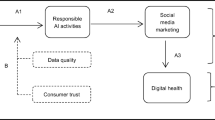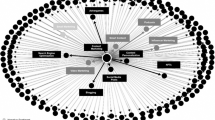Abstract
The interactions between subscribers of the health-related social networking (HSNs) platforms rise the production and sharing of a huge amount of multimedia content, daily, by permitting them to upload their medical images. These images become the centre of communication in various multilingual expressions immediately describing observations, comments and health checkups. As a part of this exchange, it is clear that these spaces are a valuable source of subscribers-generated information. Besides, it is still an open question to enable subscribers to investigate relevant information, due to the diversity of the available content. So, it is vital to engage new mechanisms in order to pull out information and acquaintance from this content. For this purpose, we have implemented a content analysis model of health-related information to get an overview of the medical content available. We present a semantic terms-based approach to pull out pertinent terms and concepts from the text material. As a result, notable extracted terms and keywords will be applied, subsequently, to present to annotate medical images, to direct users to an appropriate seeking task, through the SN site. So, the analysis method concentrates on algorithms based on statistical methods and external multilingual semantic resources to cover and treat this situation. It is essential also to deal with such ambiguities causing the efficacy decreasing of the search function. Our study is validated by a set of experiments and compared with some existing models. Experimental results have ensured that the presented model has better findings, in terms of performance and satisfaction.






Similar content being viewed by others
Notes
References
Alexander S, McLawhorn I, De Martino KA, Fehring P, Sculco K (2016) Social media and your practice: navigating the surgeon-patient relationship. Curr Rev Musculoskelet Med 9:487–495. https://doi.org/10.1007/s12178-016-9376-1
Bodenreider O (2004) The unified medical language system (UMLS): integrating biomedical terminology. Nucl Acids Res 32:267–270
Bouslimi R, Akaichi J (2015) Automatic medical image annotation on social network of physician collaboration. Netw Model Anal Health Inform Bioinforma 4:10. https://doi.org/10.1007/s13721-015-0082-5
Choi S, Choi J (2014) Exploring effective information retrieval technique for the medical web documents: SNUMedinfo at CLEFeHealth2014 task 3. In: Proceedings of the ShARe/CLEF eHealth evaluation lab
Glover M, Choy G, Boland GW et al (2015) Radiology and social media: are private practice radiology groups more social than academic radiology departments? J Am College Radiol 12(5):513–518. https://doi.org/10.1016/j.jacr.2014.11.005
Goeuriot L, Jones GJF, Kelly L, Müller H, Zobel J (2016) Medical information retrieval: introduction to the special issue. Inf Retrieval J 19:1–5. https://doi.org/10.1007/s10791-015-9277-8
Harrathi F (2010) Extraction de concepts et de relations entre concepts à partir des documents multilingues: approche statistique et ontologique. Ph.D. Thesis, INSA Lyon
Hernandeza EM, Erin P, Jonathan B (2019) Social networks and the emergence of health inequalities following a medical advance: examining prenatal H1N1 vaccination decisions. Soc Netw 58:156–167. https://doi.org/10.1016/j.socnet.2019.03.002
Hinojo-Lucena FJ, Inmaculada AD, María-Pilar CR, José-María RR (2018) Use of social networks for international collaboration among medical students. Educación Médica 21(2):137–141. https://doi.org/10.1016/j.edumed.2018.08.009
Jaccard P (1901) Distribution de la flore alpine dans le Bassin des Drouces et dans quelques regions voisines. Bull Soc Vaud Sci Nat 37(140):241–272
Jones K (1972) A statistical interpretation of term specificity and its application in retrieval. J Doc 28(1):11–21
Koopman B, Zuccon G, Bruza P, Sitbon L, Lawley M (2016) Information retrieval as semantic inference: a graph inference model applied to medical search. Informa Retrieval J 19(1–2):6–37. https://doi.org/10.1007/s10791-015-9268-9
Kordzadeh N (2016) Social media in health care. Contemporary consumer health informatics. Springer, Berlin, pp 101–23. https://doi.org/10.1007/978-3-319-25973-4_6
Kovacs W, Weisenthal S, Folio L, Li Q, Summers RM, Yao J (2016) Retrieval, visualization, and mining of large radiation dosage data. Inform Retrieval J 19(1–2):38–58. https://doi.org/10.1007/s10791-015-9265-z
Ksentini N, Tmar M, Gargour F (2014) Miracl at CLEF 2014: eHealth information retrieval task. In: Proceedings of the ShARe/CLEF eHealth evaluation lab
Levenshtein VI (1966) Binary codes capable of correcting deletions, insertions and reversals. Sov Phys Dokl 10:707–710
Lossio-Ventura JA, Jonquet C, Roche M, Teisseire M (2016) Biomedical term extraction: overview and a new methodology. Inform Retrieval J 19(1–2):59–99. https://doi.org/10.1007/s10791-015-9262-2
Maisonnasse L, Gaussier E, Chevallet J-P (2009) Combination of semantic analysis to search for medical information. In: RISE (Research Information semantics) within the INFORSID' conference, Toulouse
Manning CD, Raghavan P, Schütze H (2008) Introduction to information retrieval. Cambridge University Press, New York
Mao J, Lu K, Mu X, Li G (2015) Mining document, concept, and term associations for effective biomedical retrieval: introducing MeSH enhanced retrieval models. Inform Retrieval J 18:413–444
Markonis D, Schaer R, Muller H (2016) Evaluating multimodal relevance feedback techniques for medical image retrieval. Inform Retrieval J 19(1–2):100–112. https://doi.org/10.1007/s10791-015-9260-4
Martinez D, Otegi A, Soroa A, Agirre E (2014) Improving search over Electronic Health Records using UMLS-based query expansion through random walks. J Biomed Inform 51:100–106
McGowan BS, Wasko M, Vartabedian BS, Miller RS, Freiherr DD, Abdolrasulnia M (2012) Understanding the factors that influence the adoption and meaningful use of social media by physicians to share medical information. J Med Internet Res 14(5):e117. https://doi.org/10.2196/jmir.2138
NLM (2009) NLM Unified Medical Language System Fact Sheet. Available from: http://www.nlm.nih.gov/pubs/factsheets/umls.html.
Oh HS, Jung Y (2014) A multiple-stage approach to re-ranking clinical documents. In: Proceedings of the ShARe/CLEF eHealth evaluation lab
Ozturkmenogl O, Alpkocak A, Kilinc D (2014) Demir at CLEF eHealth the effects of selective query expansion to information retrieval. In: Proceedings of the ShARe/CLEF eHealth evaluation lab
Perrin A (2015) Social networking usage: 2005–2015. Pew Research Center. Available at: http://www.pewinternet.org/2015/10/08/2015/Social-Networking-Usage-2005-2015/. Accessed 3 Jan 2018
Ratib O (2014) Social media networks in communication between radiologists, non-radiologists and patients ECR 2014, Part A. Insights Imaging 5:69. https://doi.org/10.1007/s13244-014-0316-6
Roberts K, Simpson M, Demner-Fushman D, Voorhees E, Hersh W (2016) State-of-the-art in biomedical literature retrieval for clinical cases: a survey of the TREC 2014 CDS track. Inform Retrieval J 19(1–2):113–148. https://doi.org/10.1007/s10791-015-9259-x
Salton G (2015) The SMART retrieval system—experiments in automatic document processing. Prentice-Hall Inc, Upper Saddle River
Şenol D, Özgür U, Murat K, Cuma Ç (2021) Socio-demographic characteristics affect health information seeking on the Internet in Turkey. Health Inform Librar J. https://doi.org/10.1111/hir.12358
Sfakianaki P, Koumakis L, Sfakianakis S, Iatraki G, Zacharioudakis G, Graf N et al (2015) Semantic biomedical resource discovery: a natural language processing framework. BMC Med Inform Decision Making 15:77
Shen W, Nie JY, Liu X, Liui X (2014) An investigation of the effectiveness of concept-based approach in medical information retrieval GRIUM @ CLEF2014eHealth task 3. In: Proceedings of the ShARe/CLEF eHealth evaluation lab
Soldaini L, Yates A, Yom-Tov E, Frieder O, Goharian N (2016) Enhancing web search in the medical domain via query clarification. Inform Retrieval J 19(1–2):149–173. https://doi.org/10.1007/s10791-015-9258-y
Suominen H, et al. (2012) The proceedings of the CLEFeHealth2012—the CLEF 2012 workshop on cross-language evaluation of methods, applications, and resources for eHealth Document Analysis. NICTA
Suryavanshi T, Geier CD, Leland JM, Silverman L, Duggal N (2016) Social media and orthopaedics: opportunities and challenges. Instr Course Lect 65:645–653
Thesprasith O, Jaruskulchai C (2014) Csku gprf-qe for medical topic web retrieval. In: Proceedings of the ShARe/CLEF eHealth evaluation lab
Yanshan Wang S, Liu N, Afzal MR, Liwei W, Feichen S, Paul K, Hongfang L (2018) A comparison of word embeddings for the biomedical natural language processing. J Biomed Inform 87:12–20. https://doi.org/10.1016/j.jbi.2018.09.008
Yip HY, Taib NA, Khan HA, Dhillon SK (2019) Electronic health record integration. Encycl Bioinform Comput Biol 2:1063–1076. https://doi.org/10.1016/B978-0-12-809633-8.20306-3
Zember WF, Fishman EK, Horton KM (2015) How social media can impact medicine and radiology. J Am College Radiol 12(6):620–621. https://doi.org/10.1016/j.jacr.2014.07.030
Zong X, Xiangqian D, Zhen Z (2021) Health level classification by fusing medical evaluation from multiple social networks. Future Gener Comput Syst 114:574–580. https://doi.org/10.1016/j.future.2020.08.008
Author information
Authors and Affiliations
Corresponding author
Additional information
Publisher's Note
Springer Nature remains neutral with regard to jurisdictional claims in published maps and institutional affiliations.
Rights and permissions
About this article
Cite this article
Ayadi, M.G., Bouslimi, R. & Akaichi, J. Medical social networks content mining for a semantic annotation. Soc. Netw. Anal. Min. 12, 17 (2022). https://doi.org/10.1007/s13278-021-00848-7
Received:
Revised:
Accepted:
Published:
DOI: https://doi.org/10.1007/s13278-021-00848-7




